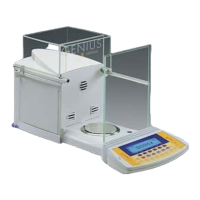Do you have a question about the Sartorius GPA3202 and is the answer not in the manual?
Read operating instructions carefully to prevent damage. Avoid hazardous areas.
Ensure voltage rating matches. Proceed with caution for RS-232 cables.
Avoid extreme temperatures, moisture, shocks, blows, or vibration.
Check equipment immediately for any external damage after unpacking.
Choose a location free from heat, drafts, vibrations, and excessive moisture.
Condition balance for 2 hours at room temperature if transferred from cold.
EU legislation requires a control seal on verified Class II balances.
Install interior draft shield, weighing pan, or filter pan as per model.
Install analytical and 3-sided draft shields, checking lock devices.
Place weighing pan or gem tray for rectangular pans up to 10 kg.
Connect AC adapter to balance, electronics box, and electrical outlet.
Adjust leveling feet to center air bubble in the level indicator for accuracy.
Identify symbols, keys, and display readouts for balance functions.
Learn to tare, assign IDs, print weights, and work with microbalances.
Use the port for a below-balance weighing hanger for specific models.
Perform internal calibration using the balance's motorized calibration weight.
Guide for external calibration using a specified external calibration weight.
Configure and use isoCAL for automatic calibration and adjustment based on conditions.
Adapt balance to ambient conditions by setting parameters using menu codes.
Reference chart for available parameter settings and their options.
Configure IDs, time, date for records, and adjust display brightness.
Weigh multiple components into a defined total weight.
Determine the number of parts by weighing a reference sample quantity.
Obtain weight readouts in percent relative to a reference weight.
Determine weights of unstable samples by averaging multiple readings.
Switch the display of weight values between two selected units.
Generate printouts with weights, values, and IDs for documentation.
Configure printouts for ambient conditions and records according to ISO/GLP.
Connect balance to computers or peripherals via serial interface.
Understand formats for control commands and data output (16/22 characters).
Identify and resolve common display errors like 'H', 'Err 01', 'Err 02'.
Guidelines for cleaning the balance housing and stainless steel parts.
Steps to safely remove components and pack the balance for transport.
Technical specifications for various Sartorius balance models.
List of optional accessories including printers, cables, and cases.
Regulations and directives concerning weighing instruments for legal metrology.
Statement of compliance with Council Directive 90/384/EEC and EN 45501.
Identification of CE mark, metrology stickers, seals, and model designation plates.
Read operating instructions carefully to prevent damage. Avoid hazardous areas.
Ensure voltage rating matches. Proceed with caution for RS-232 cables.
Avoid extreme temperatures, moisture, shocks, blows, or vibration.
Check equipment immediately for any external damage after unpacking.
Choose a location free from heat, drafts, vibrations, and excessive moisture.
Condition balance for 2 hours at room temperature if transferred from cold.
EU legislation requires a control seal on verified Class II balances.
Install interior draft shield, weighing pan, or filter pan as per model.
Install analytical and 3-sided draft shields, checking lock devices.
Place weighing pan or gem tray for rectangular pans up to 10 kg.
Connect AC adapter to balance, electronics box, and electrical outlet.
Adjust leveling feet to center air bubble in the level indicator for accuracy.
Identify symbols, keys, and display readouts for balance functions.
Learn to tare, assign IDs, print weights, and work with microbalances.
Use the port for a below-balance weighing hanger for specific models.
Perform internal calibration using the balance's motorized calibration weight.
Guide for external calibration using a specified external calibration weight.
Configure and use isoCAL for automatic calibration and adjustment based on conditions.
Adapt balance to ambient conditions by setting parameters using menu codes.
Reference chart for available parameter settings and their options.
Configure IDs, time, date for records, and adjust display brightness.
Weigh multiple components into a defined total weight.
Determine the number of parts by weighing a reference sample quantity.
Obtain weight readouts in percent relative to a reference weight.
Determine weights of unstable samples by averaging multiple readings.
Switch the display of weight values between two selected units.
Generate printouts with weights, values, and IDs for documentation.
Configure printouts for ambient conditions and records according to ISO/GLP.
Connect balance to computers or peripherals via serial interface.
Understand formats for control commands and data output (16/22 characters).
Identify and resolve common display errors like 'H', 'Err 01', 'Err 02'.
Guidelines for cleaning the balance housing and stainless steel parts.
Steps to safely remove components and pack the balance for transport.
Technical specifications for various Sartorius balance models.
List of optional accessories including printers, cables, and cases.
Regulations and directives concerning weighing instruments for legal metrology.
Statement of compliance with Council Directive 90/384/EEC and EN 45501.
Identification of CE mark, metrology stickers, seals, and model designation plates.
| Capacity | 3200 g |
|---|---|
| Readability | 0.01 g |
| Repeatability (Std. Dev.) | 0.01 g |
| Linearity | ±0.02 g |
| Stabilization Time (typical) | 1.5 s |
| Calibration | External |
| Pan Size | 180 mm |
| Interface | RS-232 |
| Power Supply | 50/60 Hz |
| Operating Temperature | 10 - 30 °C |











